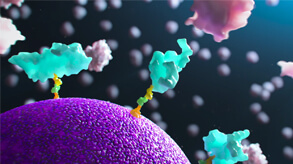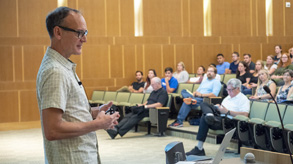The liquid liver biopsy: Characterizing NASH and NAFLD with serum protein biomarkers
ABSTRACT
With the SomaScan® Assay, predicting NASH and NAFLD is as simple as a blood test.
Nonalcoholic fatty liver disease (NAFLD) and nonalcoholic steatohepatitis (NASH) are increasingly common conditions that can progress to serious liver complications including cirrhosis and cancer. Diagnosing the severity of NAFLD and NASH has traditionally relied on invasive liver biopsies.
It was recently demonstrated that the SomaScan Assay, a multiplex proteomics platform, can noninvasively and simultaneously predict all the key elements of the liver biopsy: liver fat, inflammation, hepatocyte ballooning and fibrosis based only on serum protein biomarkers. By measuring ~5,000 proteins per sample in ~700 patients, with liver biopsy results, machine learning models were developed and validated that can reliably predict NAFLD/NASH phenotypes . The tests were used to characterize the differential mechanistic effects of three different drugs during clinical trials.
In this webinar, Dr. Steve Williams, the Chief Medical Officer for SomaLogic, will present this work and introduce a soon to be launched NASH test that is available for research use only through the SomaScan Discovery Alliance.

Stephen A. Williams, MD, PhD
Chief Medical Officer, SomaLogic
Dr. Steve Williams joined SomaLogic in 2009 as Chief Medical Officer responsible for the development of the SomaScan® Platform. Prior to SomaLogic, Dr. Williams co-founded the pharma consultancy Decisionability, LLC in 2007 and authored the book Decisionability: The Skill to Make Your Decisions Productive, Practical and Painless. From 1989-2007, Dr. Williams worked at Pfizer, Inc., initially in the Experimental Medicine group working in Exploratory Clinical Development and later as VP and Worldwide Head of Clinical Technology. From 2003-2007, Dr. Williams was on the National Advisory Council for Biomedical Imaging and Bioengineering at the National Institutes of Health. He helped to launch the Alzheimer’s Disease Neuroimaging Initiative and helped to form the FDA-FNIH-PhRMA biomarker consortium, serving on the inaugural executive committee. Dr. Williams led or co-led the PhRMA position papers on “proof of concept,” surrogate endpoints and evidentiary standards for biomarkers and diagnostics. He has degrees in physiology, medicine and surgery, and a Ph.D. in medicine and physiology from Charing Cross and Westminster Medical School (now a part of Imperial College, London). He also obtained training in diagnostic imaging at the University of Newcastle Upon Tyne.
The liquid liver biopsy: Characterizing NASH and NAFLD with serum protein biomarkers
A presentation by Stephen A. Williams, MD, PhD
More webinars
WebinarRethinking Neurodegeneration Through Blood-Based Biomarkers
Proteomics is reshaping how we predict, diagnose, and understand neurodegenerative diseases. In this roundtable, leading experts Tony Wyss-Coray, PhD, and Jacob Vogel, PhD, explore the power of blood-based biomarkers, from deep molecular studies to global-scale datasets using the SomaScan™ Assay. They discuss how protein signatures can reveal brain aging, predict dementia, and track changes in disease pathways over time, with moderation by Steve Williams, MD, PhD. Learn how cutting-edge proteomics is redefining what is possible in neurological research.
WebinarProteomics in Clinical Trials: Lessons from Semaglutide Treatment in Individuals with Obesity
Advancements in proteomic profiling have opened new avenues for understanding the complex mechanisms underlying obesity and its comorbidities. By measuring thousands of proteins at once, researchers gain a comprehensive view of an individual’s metabolic health, revealing subclinical processes and pinpointing potential therapeutic targets.
WebinarPathways to Digital Health: AI and Omics in Rheumatoid Arthritis
Explore how groundbreaking proteomic research is transforming our understanding of rheumatoid arthritis (RA). In this on-demand webinar, Allan Stensballe, PhD, shares new insights into the molecular landscape of RA-affected synovial tissue, revealing how autoantibodies and protein signatures may hold the key to more precise personalized therapies.





